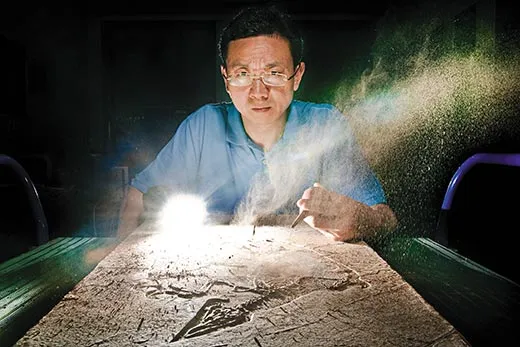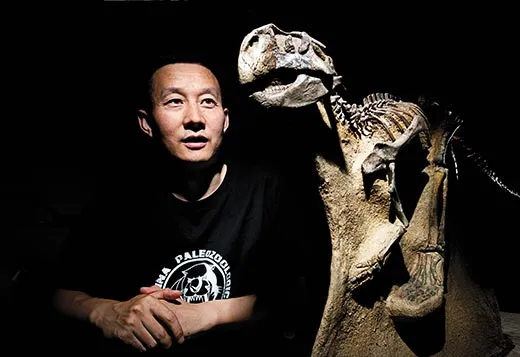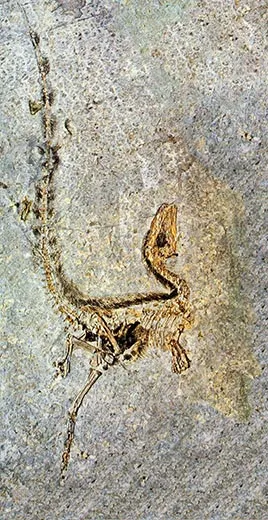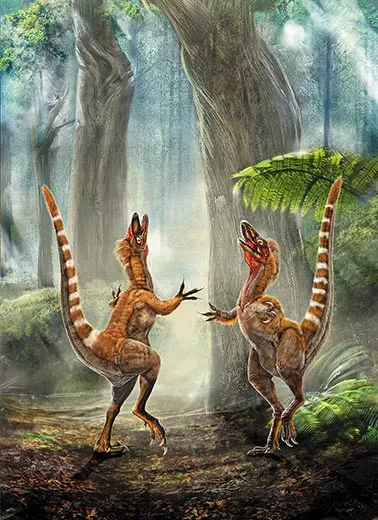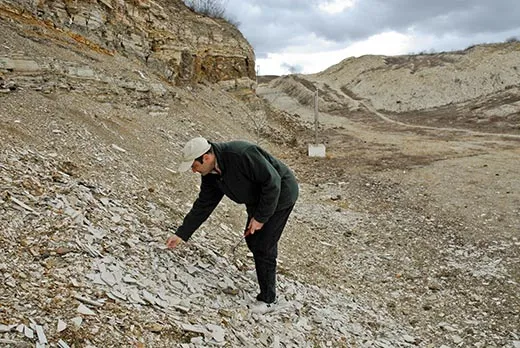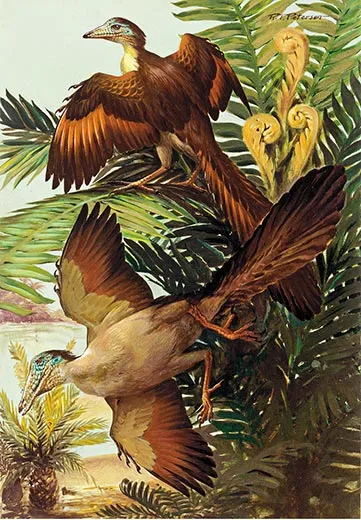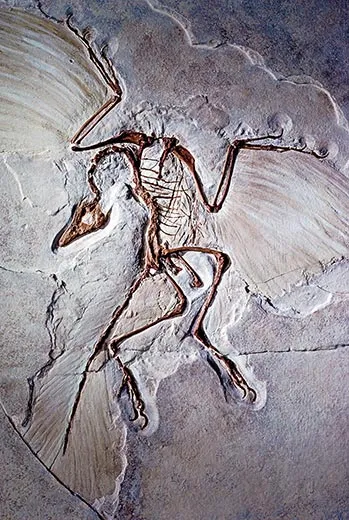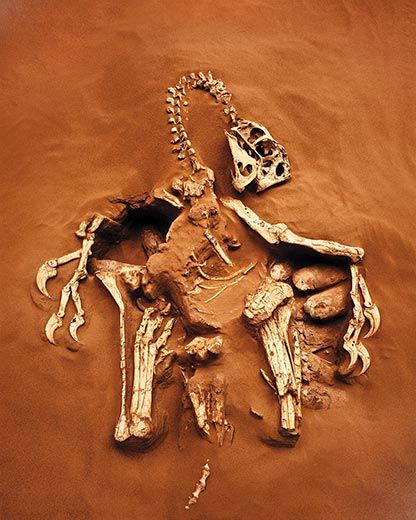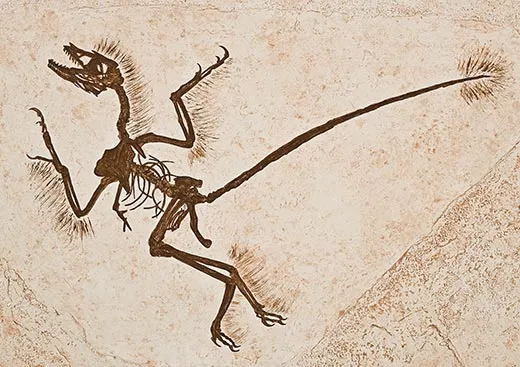Dinosaurs’ Living Descendants
China’s spectacular feathered fossils have finally answered the century-old question about the ancestors of today’s birds
/https://tf-cmsv2-smithsonianmag-media.s3.amazonaws.com/filer/China-Dinosaurs-Xu-Xing-Psittacosaurus-631.jpg)
In a pine forest in rural northeastern China, a rugged shale slope is packed with the remains of extinct creatures from 125 million years ago, when this part of Liaoning province was covered with freshwater lakes. Volcanic eruptions regularly convulsed the area at the time, entombing untold millions of reptiles, fish, snails and insects in ash. I step gingerly among the myriad fossils, pick up a shale slab not much larger than my hand and smack its edge with a rock hammer. A seam splits a russet-colored fish in half, producing mirror impressions of delicate fins and bones as thin as human hairs.
One of China's star paleontologists, Zhou Zhonghe, smiles. "Amazing place, isn't it?" he says.
It was in 1995 that Zhou and colleagues announced the discovery of a fossil from this prehistoric disaster zone that heralded a new age of paleontology. The fossil was a primitive bird the size of a crow that may have been asphyxiated by volcanic fumes as it wheeled above the lakes all those millions of years ago. They named the new species Confuciusornis, after the Chinese philosopher.
Until then, only a handful of prehistoric bird fossils had been unearthed anywhere in the world. That's partly because birds, then as now, were far less common than fish and invertebrates, and partly because birds more readily evaded mudslides, tar pits, volcanic eruptions and other geological phenomena that captured animals and preserved traces of them for the ages. Scientists have located only ten intact fossilized skeletons of the earliest known bird, Archaeopteryx, which lived at the end of the Jurassic period, about 145 million years ago.
Zhou, who works at the Institute of Vertebrate Paleontology and Paleoanthropology (IVPP) of the Chinese Academy of Sciences in Beijing, believed that the extraordinary bone beds in Liaoning might fill in some of the many blanks in the fossil record of the earliest birds. He couldn't have been more prophetic. In the past 15 years, thousands of exquisitely preserved fossil birds have emerged from the ancient lakebed, called the Yixian Formation. The region has also yielded stunning dinosaur specimens, the likes of which had never been seen before. As a result, China has been the key to solving one of the biggest questions in dinosaur science in the past 150 years: the real relationship between birds and dinosaurs.
The idea that birds—the most diverse group of land vertebrates, with nearly 10,000 living species—descended directly from dinosaurs isn't new. It was raised by the English biologist Thomas Henry Huxley in his 1870 treatise, Further Evidence of the Affinity between the Dinosaurian Reptiles and Birds. Huxley, a renowned anatomist perhaps best remembered for his ardent defense of Charles Darwin's theory of evolution, saw little difference between the bone structure of Compsognathus, a dinosaur no bigger than a turkey, and Archaeopteryx, which was discovered in Germany and described in 1861. When Huxley looked at ostriches and other modern birds, he saw smallish dinosaurs. If a baby chicken's leg bones were enlarged and fossilized, he noted, "there would be nothing in their characters to prevent us from referring them to the Dinosauria."
Still, over the decades researchers who doubted the dinosaur-bird link also made good anatomical arguments. They said dinosaurs lack a number of features that are distinctly avian, including wishbones, or fused clavicles; bones riddled with air pockets; flexible wrist joints; and three-toed feet. Moreover, the posited link seemed contrary to what everyone thought they knew: that birds are small, intelligent, speedy, warmblooded sprites, whereas dinosaurs—from the Greek for "fearfully great lizard"—were coldblooded, dull, plodding, reptile-like creatures.
In the late 1960s, a fossilized dinosaur skeleton from Montana began to undermine that assumption. Deinonychus, or "terrible claw" after the sickle-shaped talon on each hind foot, stood about 11 feet from head to tail and was a lithe predator. Moreover, its bone structure was similar to that of Archaeopteryx. Soon scientists were gathering other intriguing physical evidence, finding that fused clavicles were common in dinosaurs after all. Deinonychus and Velociraptor bones had air pockets and flexible wrist joints. Dinosaur traits were looking more birdlike all the time. "All those things were yanked out of the definition of being a bird," says paleontologist Matthew Carrano of the Smithsonian National Museum of Natural History.
But there was one important feature that had not been found in dinosaurs, and few experts would feel entirely comfortable asserting that chickadees and triceratops were kin until they had evidence for this missing anatomical link: feathers.
A poor Chinese farmer, Li Yingfang, made one of the greatest fossil finds of all time, in August 1996 in Sihetun village, an hour's drive from the site where I'd prospected for fossil fish. "I was digging holes for planting trees," recalls Li, who now has a full-time job at a dinosaur museum built at that very site. From a hole he unearthed a two-foot-long shale slab. An experienced fossil hunter, Li split the slab and beheld a creature unlike any he had seen. The skeleton had a birdlike skull, a long tail and impressions of what appeared to be feather-like structures.
Because of the feathers, Ji Qiang, then the director of the National Geological Museum, which bought one of Li's slabs, assumed it was a new species of primitive bird. But other Chinese paleontologists were convinced it was a dinosaur.
On a visit to Beijing that October, Philip Currie, a paleontologist now at the University of Alberta, saw the specimen and realized it would turn paleontology on its head. The next month, Currie, a longtime China hand, showed a photograph of it to colleagues at the annual meeting of the Society of Vertebrate Paleontology. The picture stole the show. "It was such an amazing fossil," recalls paleontologist Hans-Dieter Sues of the National Museum of Natural History. "Sensational." Western paleontologists soon made a pilgrimage to Beijing to see the fossil. "They came back dazed," Sues says.
Despite the feathers, the skeleton left no doubt that the new species, named Sinosauropteryx, meaning "Chinese lizard wing," was a dinosaur. It lived around 125 million years ago, based on the dating of radioactive elements in the sediments that encased the fossil. Its integumentary filaments—long, thin structures protruding from its scaly skin—convinced most paleontologists that the animal was the first feathered dinosaur ever unearthed. A dozen dinosaurs with filaments or feathers have since been discovered at that site.
By analyzing specimens from China, paleontologists have filled in gaps in the fossil record and traced the evolutionary relationships among various dinosaurs. The fossils finally have confirmed, to all but a few skeptics, that birds descended from dinosaurs and are the living representatives of a dinosaur lineage called the Maniraptorans.
Most dinosaurs were not part of the lineage that gave rise to birds; they occupied other branches of the dinosaur family tree. Sinosauropteryx, in fact, was what paleontologists call a non-avian dinosaur, even though it had feathers. This insight has prompted paleontologists to revise their view of other non-avian dinosaurs, such as the notorious meat eater Velociraptor and even some members of the tyrannosaur group. They, too, were probably adorned with feathers.
The abundance of feathered fossils has allowed paleontologists to examine a fundamental question: Why did feathers evolve? Today, it's clear that feathers perform many functions: they help birds retain body heat, repel water and attract a mate. And of course they aid flight—but not always, as ostriches and penguins, which have feathers but do not fly, demonstrate. Many feathered dinosaurs did not have wings or were too heavy, relative to the length of their feathered limbs, to fly.
Deciphering how feathers morphed over the ages from spindly fibers to delicate instruments of flight would shed light on the transition of dinosaurs to birds, and how natural selection forged this complex trait. Few scientists know ancient feathers more intimately than IVPP's Xu Xing. He has discovered 40 dinosaur species—more than any other living scientist—from all over China. His office at IVPP, across the street from the Beijing Zoo, is cluttered with fossils and casts.
Xu envisions feather evolution as an incremental process. Feathers in their most primitive form were single filaments, resembling quills, that jutted from reptilian skin. These simple structures go way back; even pterodactyls had filaments of sorts. Xu suggests that feather evolution may have gotten started in a common ancestor of pterodactyls and dinosaurs—nearly 240 million years ago, or some 95 million years before Archaeopteryx.
After the emergence of single filaments came multiple filaments joined at the base. Next to appear in the fossil record were paired barbs shooting off a central shaft. Eventually, dense rows of interlocking barbs formed a flat surface: the basic blueprint of the so-called pennaceous feathers of modern birds. All these feather types have been found in fossil impressions of theropods, the dinosaur suborder that includes Tyrannosaurus rex as well as birds and other Maniraptorans.
Filaments are found elsewhere in the dinosaur family tree as well, in species far removed from theropods, such as Psittacosaurus, a parrot-faced herbivore that arose around 130 million years ago. It had sparse single filaments along its tail. It's not clear why filaments appear in some dinosaur lineages but not in others. "One possibility is that feather-like structures evolved very early in dinosaur history," says Xu, and some groups maintained the structures, while other groups lost them. "But finally in Maniraptorans, feathers stabilized and evolved into modern feathers," he says. Or filaments may have evolved independently at different times. As Sues points out, "It seems that, genetically, it's not a great trick to make a scale into a filament."
Originally, single filaments may well have been for display, the dinosaur equivalent of a peacock's iridescent plumage. Vivid evidence for that theory appeared when scientists unveiled the true colors of 125-million-year-old feathers. Bird feathers and reptile scales contain melanosomes—tiny sacs holding varieties of the pigment melanin. Many paleontologists suspected that dinosaur feathers also contained melanosomes. In Mike Benton's laboratory at the University of Bristol, IVPP's Zhang Fucheng spent more than a year searching for melanosomes in photographs of bird and dinosaur fossils taken with an electron microscope. Zhang's diligence paid off in 2009 when he pinpointed melanosomes in Confuciusornis that contained eumelanin, which gives feathers a gray or black tinge, and pheomelanin, which gives them a chestnut to reddish-brown color. The animal's feathers had patches of white, black and orange-brown coloring.
Sinosauropteryx was even more stunning. Zhang found that the filaments running down its back and tail must have made the dinosaur look like an orange-and-white-striped barber pole. Such a vibrant pattern suggests that "feathers first arose as agents for color display," Benton says.
Early feathers could have served other purposes. Hollow filaments may have dissipated heat, much as the frills of some modern lizards do today. Other paleontologists speculate feathers first evolved to retain heat. A telling example comes from fossils of Oviraptor—a theropod unearthed in Mongolia that lived around 75 million years ago—squatting over egg-filled nests. Oviraptors tucked their legs into the center of the clutch and hugged the periphery with their long forelimbs—a posture bearing an uncanny resemblance to brooding birds keeping their eggs warm. Dinosaurs related to Oviraptor were covered with pennaceous feathers, suggesting that Oviraptor was as well. "Sitting on a nest like that only made sense if it had feathers" to gently insulate its young, says Sues.
Feathers did, of course, eventually become an instrument of flight. Some paleontologists envision a scenario in which dinosaurs used feathers to help them occupy trees for the first time. "Because dinosaurs had hinged ankles, they could not rotate their feet and they couldn't climb well. Maybe feathers helped them scramble up tree trunks," Carrano says. Baby birds of primarily ground-dwelling species like turkeys use their wings in this way. Feathers may have become increasingly aerodynamic over millions of years, eventually allowing dinosaurs to glide from tree to tree. Individuals able to perform such a feat might have been able to reach new food sources or better escape predators—and pass the trait on to subsequent generations.
One of the most beguiling specimens to emerge from Liaoning's shale beds is Microraptor, which Xu discovered in 2003. The bantamweight beast was a foot or two long and tipped the scales at a mere two pounds. Microraptor, from the Dromaeosaur family, was not an ancestor of birds, but it was also unlike any previously discovered feathered dinosaur. Xu calls it a "four-winged" dinosaur because it had long, pennaceous feathers on its arms and legs. Because of its fused breastbone and asymmetrical feathers, says Xu, Microraptor surely could glide from tree to tree, and it may even have been better at flying under its own power than Archaeopteryx was.
Last year, Xu discovered another species of four-winged dinosaur, also at Liaoning. Besides showing that four-winged flight was not a fluke, the new species, Anchiornis huxleyi, named in honor of Thomas Henry Huxley, is the earliest known feathered dinosaur. It came from Jurassic lakebed deposits 155 million to 160 million years old. The find eliminated the final objection to the evolutionary link between birds and dinosaurs. For years, skeptics had raised the so-called temporal paradox: there were no feathered dinosaurs older than Archaeopteryx, so birds could not have arisen from dinosaurs. Now that argument was blown away: Anchiornis is millions of years older than Archaeopteryx.
Four-winged dinosaurs were ultimately a dead branch on the tree of life; they disappear from the fossil record around 80 million years ago. Their demise left only one dinosaur lineage capable of flight: birds.
Just when did dinosaurs evolve into birds? Hard to say. "Deep in evolutionary history, it is extremely difficult to draw the line between birds and dinosaurs," says Xu. Aside from minor differences in the shape of neck vertebrae and the relative length of the arms, early birds and their Maniraptoran kin, such as Velociraptor, look very much alike.
"If Archaeopteryx were discovered today, I don't think you would call it a bird. You would call it a feathered dinosaur," says Carrano. It's still called the first bird, but more for historic reasons than because it is the oldest or best embodiment of birdlike traits.
On the other hand, Confuciusornis, which possessed the first beak and earliest pygostyle, or fused tail vertebrae that supported feathers, truly looks like a bird. "It passes the sniff test," Carrano says.
Since the last of the non-avian dinosaurs died out 65 million years ago during the mass extinction that closed the curtain on the Cretaceous period, birds have evolved other characteristics that set them apart from dinosaurs. Modern birds have higher metabolisms than even the most agile Velociraptor ever had. Teeth disappeared at some point in birds' evolutionary history. Birds' tails got shorter, their flying skills got better and their brains got bigger than those of dinosaurs. And modern birds, unlike their Maniraptoran ancestors, have a big toe that juts away from the other toes, which allows birds to perch. "You gradually go from the long arms and huge hands of non-avian Maniraptorans to something that looks like the chicken wing you get at KFC," says Sues. Given the extent of these avian adaptations, it's no wonder the evolutionary link between dinosaurs and birds as we know them remained hidden until paleontologists started analyzing the rich fossil record from China.
Chaoyang is a drab Chinese city with dusty streets; in its darker corners it's reminiscent of gritty 19th-century American coal-mining towns. But to fossil collectors, Chaoyang is a paradise, only a one-hour drive from some of the Yixian Formation's most productive beds.
One street is lined with shops selling yuhuashi, or fish fossils. Framed fossils embedded in shale, often in mirror-image pairs, can be had for a dollar or two. A popular item is a mosaic in which a few dozen small slabs form a map of China; fossil fish appear to swim toward the capital, Beijing (and no map is complete without a fish representing Taiwan). Merchants sell fossilized insects, crustaceans and plants. Occasionally, despite laws that forbid trade in fossils of scientific value, less scrupulous dealers have been known to sell dinosaur fossils. The most important specimens, Zhou says, "are not discovered by scientists at the city's fossil shops, but at the homes of the dealers or farmers who dug them."
In addition to Sinosauropteryx, several other revelatory specimens came to light through amateurs rather than at scientific excavations. The challenge for Zhou and his colleagues is to find hot specimens before they disappear into private collections. Thus Zhou and his colleague Zhang Jiangyong, a specialist on ancient fish at IVPP, have come to Liaoning province to check out any fossils that dealers friendly to their cause have gotten their hands on of late.
Most of the stock in the fossil shops comes from farmers who hack away at fossil beds when they aren't tending their fields. A tiny well-preserved fish specimen can yield its finder the equivalent of 25 cents, enough for a hot meal. A feathered dinosaur can earn several thousand dollars, a year's income or more. Destructive as it is to the fossil beds, this paleo economy has helped rewrite prehistory.
Zhou picks up a slab and peers at it through his wire-rimmed glasses. "Chairman, come here and look," Zhou says to Zhang (who earned his playful nickname as chairman of IVPP's employees union). Zhang examines the specimen and adds it to a pile that will be hauled back to Beijing for study—and, if they are lucky, reveal another hidden branch of the tree of life.
Richard Stone has written about a Stonehenge burial, a rare antelope and mysterious Tibetan towers for Smithsonian.
